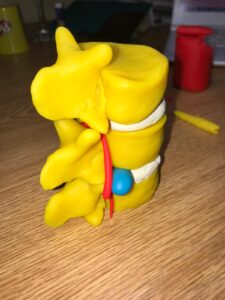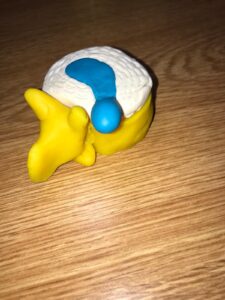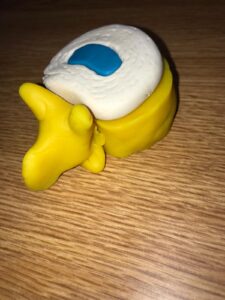STEAM Project
For my STEAM project, I decided to replicate 3 vertebrae of the lumbar spine and two intervertebral discs. One of the discs is healthy, but the other is ruptured. I created these replicas out of Play-Doh. My goal for this project is to explain what a herniated disc is, how and why a herniated disc can occur, how it can affect the nerves, why a herniated disc can be very painful, and show what a herniated disc looks like. I chose to do this project because I have a herniated disc and I think that it is important for other people to learn about it because many people have this injury.
An intervertebral disc consists of a nucleus, which is the inside gel-like center, and an annulus which is the wall of an intervertebral disc. Once the disc is ruptured the nucleus of the disc squeezes out. When the nucleus is inside the disc, it has a gel-like substance, but once it is out of the disc it hardens and stays on the outside of the annulus which is the herniation. If the herniation presses on the spinal nerve, it can be excruciating, but in some cases, the hernia does not interfere with the nerve and this person can be considered lucky because in that case there is no pain shooting down the leg.
According to the article, Three-dimensional analysis of spinopelvic alignment in individuals with acutely herniated lumbar intervertebral disc, “Pain from a herniated disc can vary, depending on the location and severity of the injury. It is typically felt on one side of the body due to nerve root irritation.” I have learned that the pain of a herniated disc varies from person to person because of the pain response that people have, but most importantly it depends on the location of the herniation. If the disc ruptures and the herniation irritates the spinal nerve then there is a chemical reaction that leads to spinal nerve inflammation. If this occurs the pain can radiate from the lumbar area to one or both legs and feet. The pain shooting from the irritated spinal nerve can be compared to an electric shock when doing everyday activities like walking, standing, sitting, or even twisting your body. For some people who have a more severe herniation, there can be numbness and tingling in the legs and feet because of the sciatica nerve being pressed and interfered with. You can also feel weakness in one or both legs, as well as have a loss of bladder and bowel function control.
As said in an article from Mayfield Brain & Spine, “Most herniated discs occur in the lumbar spine, where spinal nerves exit between the lumbar vertebrae, and then join together again to form the sciatic nerve, which runs down your leg.’’ A herniated intervertebral disc can occur for people in every age group. Usually, older people get it because the nucleus of the disc can dry out and become harder and the annulus of the disc can become thinner and weaker with time. For all age groups, it can happen when lifting weights inappropriately, which is the cause for most herniated discs.




Markuss and I both did our STEAM projects on the spine. He focused his project on what a herniated disc is, how it occurs, and their effect on nerves. I think this idea of a project is cool and interesting, especially because it is something he currently is experiencing, so thank you for sharing!
He explained that a herniation is formed when the nucleus finds its way out of the intervertebral disc and hardens outside the annulus. This hardened projection can press on the spinal nerve and send pain down the leg, but sometimes doesn’t bother anything. He also mentioned that when pain does occur, it can vary depending on the person, but it usually is on one side of the body. There could be a possibility of pain and weakness in both the legs and feet, and even can affect bladder and bowel control. Markus also pointed out that herniated discs can develop in people at any age, but it most commonly found in the geriatric patients. The most commonly found reason for a herniated disc would be from weightlifting inappropriately.
I appreciate that Markuss was assigned as my partner. I learned a lot through reading his essay and seeing the visualization of a normal and herniated disc. I liked that he showed the vertebral discs in three different ways; what it looks like normally, the herniated disc, and how it looks all together. This type of injury is something you hear of often but, at least for me, don’t fully know what it is. Markuss, I hope you get better quickly and good job on this project!